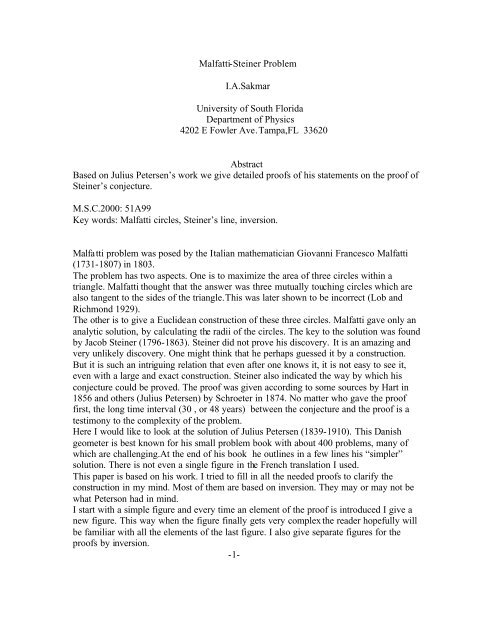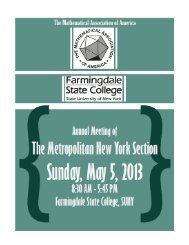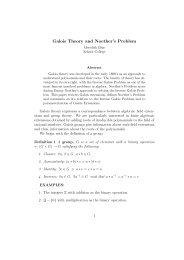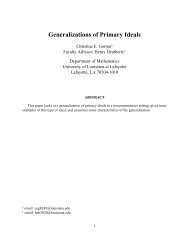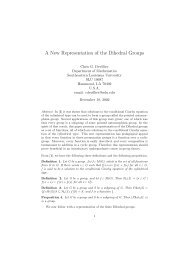Malfatti-Steiner Problem I. A. Sakmar, University of ... - MAA Sections
Malfatti-Steiner Problem I. A. Sakmar, University of ... - MAA Sections
Malfatti-Steiner Problem I. A. Sakmar, University of ... - MAA Sections
Create successful ePaper yourself
Turn your PDF publications into a flip-book with our unique Google optimized e-Paper software.
<strong>Malfatti</strong>-<strong>Steiner</strong> <strong>Problem</strong><br />
I.A.<strong>Sakmar</strong><br />
<strong>University</strong> <strong>of</strong> South Florida<br />
Department <strong>of</strong> Physics<br />
4202 E Fowler Ave.Tampa,FL 33620<br />
Abstract<br />
Based on Julius Petersen’s work we give detailed pro<strong>of</strong>s <strong>of</strong> his statements on the pro<strong>of</strong> <strong>of</strong><br />
<strong>Steiner</strong>’s conjecture.<br />
M.S.C.2000: 51A99<br />
Key words: <strong>Malfatti</strong> circles, <strong>Steiner</strong>’s line, inversion.<br />
<strong>Malfatti</strong> problem was posed by the Italian mathematician Giovanni Francesco <strong>Malfatti</strong><br />
(1731-1807) in 1803.<br />
The problem has two aspects. One is to maximize the area <strong>of</strong> three circles within a<br />
triangle. <strong>Malfatti</strong> thought that the answer was three mutually touching circles which are<br />
also tangent to the sides <strong>of</strong> the triangle.This was later shown to be incorrect (Lob and<br />
Richmond 1929).<br />
The other is to give a Euclidean construction <strong>of</strong> these three circles. <strong>Malfatti</strong> gave only an<br />
analytic solution, by calculating the radii <strong>of</strong> the circles. The key to the solution was found<br />
by Jacob <strong>Steiner</strong> (1796-1863). <strong>Steiner</strong> did not prove his discovery. It is an amazing and<br />
very unlikely discovery. One might think that he perhaps guessed it by a construction.<br />
But it is such an intriguing relation that even after one knows it, it is not easy to see it,<br />
even with a large and exact construction. <strong>Steiner</strong> also indicated the way by which his<br />
conjecture could be proved. The pro<strong>of</strong> was given according to some sources by Hart in<br />
1856 and others (Julius Petersen) by Schroeter in 1874. No matter who gave the pro<strong>of</strong><br />
first, the long time interval (30 , or 48 years) between the conjecture and the pro<strong>of</strong> is a<br />
testimony to the complexity <strong>of</strong> the problem.<br />
Here I would like to look at the solution <strong>of</strong> Julius Petersen (1839-1910). This Danish<br />
geometer is best known for his small problem book with about 400 problems, many <strong>of</strong><br />
which are challenging.At the end <strong>of</strong> his book he outlines in a few lines his “simpler”<br />
solution. There is not even a single figure in the French translation I used.<br />
This paper is based on his work. I tried to fill in all the needed pro<strong>of</strong>s to clarify the<br />
construction in my mind. Most <strong>of</strong> them are based on inversion. They may or may not be<br />
what Peterson had in mind.<br />
I start with a simple figure and every time an element <strong>of</strong> the pro<strong>of</strong> is introduced I give a<br />
new figure. This way when the figure finally gets very complex the reader hopefully will<br />
be familiar with all the elements <strong>of</strong> the last figure. I also give separate figures for the<br />
pro<strong>of</strong>s by inversion.<br />
-1-
Fig.1<br />
Take the triangle ABC.Consider the problem solved.<br />
Call the circles S a , S b, and S c .<br />
Let their mutual contact points be a , ß , and ?.<br />
Let the points where they touch the sides AB and CA be C 1 , C 2 and ß 1 , ß 2<br />
Fig.2<br />
Draw the circle which is tangent to the circles S a , and S b at their contact point<br />
ß and goes through the point C 2 .<br />
Call this circle S M, and its center M.<br />
-2-
Call the intersection <strong>of</strong> S M with the side CA D.<br />
Draw two tangent lines to the circle SM at points C 2 and D.<br />
Call the intersection point <strong>of</strong> these tangent lines F.<br />
We claim that the circle S M intersects the circle S b and the side CA under<br />
equal angles.<br />
That is, the angle ∠ AC 2 F is complementary to the angle ∠ FDA.<br />
Fig.3<br />
Pro<strong>of</strong>:<br />
Theorem:<br />
Given two circles S 1, and S 2 which intersect each other at points A, and B.<br />
Any circle C which goes through A and B intersects all circles like C a , and C ß<br />
which are tangent to S 1 , and S 2 under equal angles. (Complementary angles if<br />
the circles are on opposite sides.)<br />
-3-
Fig.4<br />
We invert the system with respect to the inversion center A. With this inversion<br />
S 1 becomes a line l 1<br />
S 2 becomes a line l 2<br />
C becomes a line l<br />
The point A, being the inversion center goes to infinity.<br />
The point B becomes B’.<br />
The linesl 1 , l 2 , and l go through the point B’, because the circles S 1 , S 2 , and<br />
C go through the point B.<br />
The circles C a and C ß become again circles C’ a , and C’ ß since they don’t go<br />
through the inversion center A.<br />
The circles C’ a , and C’ ß are tangent to the lines l 1 ,and l 2 because the circles<br />
C a , and C ß were tangent to the circles S 1 , and S 2 before the inversion.<br />
From the inverted drawing it is seen that the line l intersects the circles C’ a ,<br />
and C’ ß under equal angles .<br />
Since the inversion does not change angles, the uninverted circle C intersects the<br />
uninverted circles C a , and C ß under equal angles. (If C a , and C ß are on opposite<br />
sides, the angles are complementary.)<br />
-4-
In our case the circles S 1 , and S 2 are S a , and S c. The points A and B coincide at<br />
the point ß, since in our case S a , and S c are tangent.<br />
The tangent circles C a , and C ß are in our case S b , and the line CA (degenerate<br />
circle with its center at infinity).<br />
The circle C is in our case S M .<br />
Thus we showed that the circle S M intersects S b , and CA under complementary<br />
angles.<br />
That is<br />
∠ FC 2 A + ∠ FDA = 180 o<br />
Fig.5<br />
Consider the quadrilaterals MC 2 FD and MC 2 FD.<br />
-5-
We just proved that the opposed angles at C 2 and D in the quadrilateral AC 2 FD<br />
add up to 180 o .<br />
Now in the quadrilateral MC 2 FD the tangent C 2 F is ⊥ to the radius MC 2 .<br />
Thus the angle ∠ MC 2 F = 90 o .<br />
Similarly FD ⊥ MD. Thus the angle ∠ FDM = 90 o .<br />
Hence the sum <strong>of</strong> these two opposite angles is 180 o .<br />
Also, the two quadrilaterals have the angle ∠ C 2 FD common.<br />
Thus ∠ C 2 MD = ∠ C 2 AD.<br />
Now connect A to F. We will prove that AF is the bisector <strong>of</strong> the angle<br />
∠ C 2 MD=∠ A.<br />
Let D’ be the point on AB with FC 2 = FD’.<br />
The triangles AD’F = ADF. Because:<br />
1) AF = AF is common to both triangles.<br />
2) FD = FD’ .Because FD=FC 2 are tangents to the circle S M and we took<br />
FD’ = FC 2 .<br />
3) ∠ AD’F = ∠ ADF. Because the triangle C 2 FD’ being isosceles ∠ ADF<br />
is complementary to ∠ AC 2 F. But we also showed that ∠ FDA is<br />
complementary to ∠ AC 2 F.<br />
Hence AD’F = ADF<br />
Fig.5<br />
We now claim that the points a, ß, C 1 , and C 2 lie on a circle . We shall call<br />
this circle S t and prove the claim below.<br />
-6-
Fig.6<br />
Theorem:<br />
Given two mutually tangent circles S a , and S b which touch at ?. Consider<br />
the circles S c , and S d which touch S a , and S b ats the points a, ß, d, and e.<br />
The points a, ß, d, and e lie on a circle.<br />
The pro<strong>of</strong> is again by inversion. Take ? as the center <strong>of</strong> inversion. S a , and S b<br />
become under inversion two lines l a , and l b . the point ? goes to infinity.<br />
Since S a , and S b do not have a second intersection point (they are tangent)<br />
they become parallel lines under inversion.<br />
S c , and S d are tangent to both S a , and S b . therefore their images must be<br />
tangent to the inverted images <strong>of</strong> S a , and S b .<br />
Fig.7<br />
Obviously the points a’, ß’, d’, and e’ lie on a circle. Because they lie at the<br />
corners <strong>of</strong> a rectangle. Hence the inverted image <strong>of</strong> this circle goes through<br />
the points a, ß, d, and e.<br />
In our case S d is degenerate ( it is the line C 1 C 2 tangent to the circles Sa, and<br />
S b ). Thus we established that the points a, ß, C 1 , and C 2 lie on a circle , we<br />
called S t .<br />
-7-
Fig.8 Draw the circle through ß, D, and ß 2 . Call this circle S u .<br />
S u intersects S t at E.<br />
Connect C 1 to E, also ß 2 to E.<br />
Connect C 2 to ß, also E to ß.<br />
We will prove that E lies on the circle with the center A, which goes through<br />
C 1 , and ß 2 .<br />
From the circle S t ∠ C 1 Eß = 180 o – ∠ C 1 C 2 ß<br />
From the circle S u<br />
∠ ß 2 Eß = 180 o – ∠ ß 2 Dß<br />
Adding<br />
∠ C 1 Eß + ∠ ß 2 Eß = 360 o – (∠ C 1 C 2 ß + ∠ ß 2 Dß)<br />
But ∠ C 1 Eß + ∠ ß 2 Eß = 360 o – ∠ C 1 Eß 2<br />
Hence ∠ C 1 Eß 2 = ∠ C 1 C 2 ß + ∠ ß 2 Dß<br />
But ∠ C 1 C 2 ß + ∠ ß 2 Dß = 360 o – ∠ A – ∠ C 2 ßD<br />
∠ C 2 ßD is an angle in the circle S M and ∠ C 2 ßD = 180 o -<br />
2<br />
1 ∠ A<br />
Finally ∠ C 1 Eß 2 = 360 o - ∠ A - 180 o + ∠<br />
2<br />
1 A = 180 o - ∠<br />
2<br />
1 A<br />
-8-
This shows that E is on the circle with the center A and which goes through<br />
C 1 and ß 2 .<br />
Fig.9 Consider the circle S t.<br />
C 1 C 2 = EL Because AC 1 = AE<br />
We prove now that C 2 K = C 1 C 2<br />
To show that these two segments <strong>of</strong> the circle S t are equal, we will prove<br />
that the angles they make with the tangent to S t at C 2 are equal. That is<br />
? = ?’<br />
-9-
Fig.10 We invert the system with respect to the inversion center ? .<br />
The circle S a becomes a line l a .<br />
The circle S b becomes a line l b .<br />
These two lines are parallel because the only common point ? <strong>of</strong> the two<br />
circles S a and S b goes to infinity.<br />
The line C 1 C 2 becomes a circle.<br />
Thus S b and C 1 C 2 exchange roles under inversion.<br />
Before the inversion the line C 1 C 2 is tangent to the circle S b .<br />
After the inversion the circle C’ 1 C’ 2 is tangent to the line l b .<br />
Also, the line C 1 C 2 was tangent to the circles S a , and S b before the inversion..<br />
After the inversion the circle C’ 1 C’ 2 becomes tangent to the parallel lines l a ,<br />
and l b .<br />
The circle S M through the points C 2 and ß becomes a circle S’ M through the<br />
points C’ 2 , an ß’.<br />
The circle S t through the points C 1 ,C 2 and ß becomes a circle S’ t through the<br />
points C’ 1 , C’ 2 , and ß’.<br />
-10-
The circle S C which was tangent to the circles S a , and S b before the inversion<br />
becomes a circle S’ C tangent to the parallel lines l a , and l b after the inversion.<br />
Consider now the inverted drawing.<br />
Because l a is tangent to S’ M at ß’, a perpendicular line to this tangent goes<br />
through the center M’ <strong>of</strong> S’ M .<br />
Take the tangent line (4) to S’ M at C’ 2 and draw a perpendicular line (3) to this<br />
tangent. This perpendicular line goes through the center M’ <strong>of</strong> S’ M .<br />
Note also that C’ 2 ß’ is a diameter <strong>of</strong> S’ t .<br />
In the uninverted drawing ? is the angle between C 2 F (tangent to S M at C 2 )<br />
and the tangent to S t at C 2 .<br />
When this is inverted ? is the angle between the line (4) (tangent to S’ M at C’ 2 )<br />
and the line (2) (tangent to S’ t at C’ 2 ).<br />
The line (1) C’ 2 ß’ is ⊥ to the line (2), because a radius <strong>of</strong> S’ t is ⊥ to the<br />
tangent <strong>of</strong> S’ t .<br />
Also the line (3) C’ 2 M’ is ⊥ to the line (4), because a radius <strong>of</strong> S’ M is ⊥<br />
to the tangent <strong>of</strong> S’ M .<br />
Hence ? = ? 1<br />
Next in the uninverted drawing , ?’ is the angle between the tangent to S t at C 2<br />
and C 1 C 2 which is the tangent line to the circle S b .<br />
When this is inverted, the tangent to S t at C 2 becomes the tangent to S’ t at C’ 2<br />
which is the line (2).<br />
C 1 C 2 , which was the tangent line to the circle S b becomes the circle C’ 1 C’ 2<br />
tangent to the line l b . Thus ?’ is the angle between the lines (2) and l b .<br />
Now M’ß’ ⊥ l b<br />
Line (1) ⊥ Line (2)<br />
? 1 = ?’ 1<br />
But we already found that ? = ? 1 .<br />
Thus ? = ? 1 = ?’ 1 = ?’<br />
? = ?’<br />
since the inversion does not change angles at intersections <strong>of</strong> curves, we find that<br />
also in the uninverted drawing<br />
? = ?’ .<br />
this proves that C 2 K = C 2 C 1<br />
Because these segments are the corresponding segments to the tangent line to S t<br />
at C 2 with equal angles.<br />
We now observe that the circles S t and S u play similar roles with respect to<br />
circle S M and the point F. We proved that C 2 C 1 =C 2 K where C 2 K is on the<br />
tangent from F to CM. Exactly the same pro<strong>of</strong> can be given to show that<br />
Dß 2 =DV where DV is on the tangent from F to C M . consequently EU=DV.<br />
-11-
Fig.11. There remains one more point to be proven. Namely, the line AE goes through F.<br />
This we prove now:<br />
Suppose AE does not go through F. Let us call the intersection points <strong>of</strong> AE with<br />
the tangent line C 2 F G and with the tangent line FD H.<br />
It then follows:<br />
(1) FC 2 = FD (Tangents to the same circle S M )<br />
(2) GC 2 = GE (Because <strong>of</strong> the equality <strong>of</strong> the segments C 2 K = EL )<br />
(3) HD = HE (Because <strong>of</strong> the equality <strong>of</strong> the segments EU = DV )<br />
Subtracting (1)-(2) GC 2 – FC 2 = FG = FD-GE = FH+HD-(GH+HE)<br />
FG = FH-GH+HD-HE<br />
FG+GH = FH<br />
This tells us that the sum <strong>of</strong> the two sides <strong>of</strong> a triangle equals its third side.<br />
Hence F, G and H are one and the<br />
-12-
This means that E is on the bisector AF.<br />
Fig.12. Now we show that the segment XY <strong>of</strong> the bisector <strong>of</strong> the angle ∠ B is also<br />
equal to the segments we discussed. Namely:<br />
XY = C 2 C 1 = C 2 K = EL<br />
The reason for this is as follows:<br />
The segment C 2 C 1 plays similar roles with respect to the two sides <strong>of</strong> our triangle<br />
(<strong>of</strong> A and B).<br />
We focused on the circles S a and S u on the A side. We thus found that<br />
AC 1 = AE and C 2 C 1 = EL.<br />
Had we constructed the analogue <strong>of</strong> the circle S u on the B corner side, we would<br />
have found the counterpart <strong>of</strong><br />
C 2 C 1 = EL which is C 2 C 1 = XY.<br />
Next, construct the tangent line to S a and S c at ß.<br />
This gives us the segment ßZ, and<br />
ßZ = C 1 C 2 .<br />
The reason for this is as follows:<br />
Consider the circles S t and S a . they intersect at C 1 and ß. If we construct at C 1<br />
and ß tangents to S a they are symmetric with respect to the line connecting the<br />
centers <strong>of</strong> S t , and S a . Therefore<br />
ßZ = C 1 C 2 .<br />
-13-
Thus we have the following segments <strong>of</strong> S t which are all equal.<br />
C 1 C 2 = EL = C 2 K = XY = ßZ<br />
Consequently we can draw a circle which is tangent to all those segments. Let us<br />
call this circle S v . Obviously S v has the same center as the circle S t . this circle<br />
is also seen to be the in-circle <strong>of</strong> the triangle ABO where O is the intersection<br />
point <strong>of</strong> the bisectors <strong>of</strong> the triangle ABC.<br />
Moreover the tangent to the circles S a , and S c at ß is also tangent to this circle<br />
S v .<br />
Finally this very tangent is also tangent to the in-circle <strong>of</strong> the triangle OBC,<br />
which we will call S w . The reason for this is that the roles <strong>of</strong> S v and S w with<br />
respect to the circles S a , and S c are similar. Had we focused on S w instead <strong>of</strong><br />
on S v we would find that the tangent line to S a and S c at ß is also tangent to<br />
the circle S w . This finally proves <strong>Steiner</strong>’s conjecture.<br />
Fig.13 <strong>Steiner</strong>’s Conjecture:<br />
Suppose the problem <strong>of</strong> finding three <strong>Malfatti</strong> circles is solved. Then the tangent<br />
line to two <strong>of</strong> these three circles , say S a and S c at their contact point ß is<br />
tangent to both <strong>of</strong> the circles S v , and S w inscribed into the triangles ABO and<br />
OBC where O is the intersection point <strong>of</strong> the bisectors <strong>of</strong> the angles <strong>of</strong> the<br />
given triangle ABC.<br />
-14-
Fig.14 Since <strong>Steiner</strong>’s line is so difficult to recognize in an actual triangle ,we give here<br />
an exaggerated picture <strong>of</strong> it. Here S a and S c are two <strong>of</strong> the <strong>Malfatti</strong>-<strong>Steiner</strong><br />
circles. The other circles are two <strong>of</strong> the circles inscribed into the triangles formed<br />
by one side <strong>of</strong> the triangle and two <strong>of</strong> the bisectors.<br />
Fig.15 Construction:<br />
Constructing the three bisectors AO, BO, and CO <strong>of</strong> the triangle ABC , three<br />
triangles are found. Construct the in-circle S v <strong>of</strong> the triangle ABO.<br />
Construct the in-circle S w <strong>of</strong> the triangle OBC.<br />
-15-
Construct one <strong>of</strong> the common inner tangents <strong>of</strong> the circles S v and S w. Call this<br />
line the <strong>Steiner</strong> line.<br />
<strong>Steiner</strong> line is also tangent to one <strong>of</strong> the three <strong>Malfatti</strong> circles. Thus the problem<br />
is to construct the circle which touches two sides, say AB and CA <strong>of</strong> the<br />
triangle ABC and the <strong>Steiner</strong> line.<br />
To construct the common inner tangent <strong>of</strong> two given circles with centers C 1 , and<br />
C 2 and radii R 1 , and R 2 we draw around the circle C 1 a circle with radius<br />
R 1 + R 2 .<br />
We next draw a tangent from the point C 2 to this circle . Finally we draw a<br />
parallel line to this tangent at a distance R 2 on the circle’s side. This gives the<br />
common inner tangent <strong>of</strong> the given circle.<br />
-16-
A C K N O W L E D G M E N T S<br />
I dedicate this paper to my late friend Umit Camat, who gave me Julius Petersen’s book<br />
as a present. Without him I would not have the motivation for working on this problem.<br />
I am grateful to Dr.Denver Jones for pro<strong>of</strong>-reading the manuscript<br />
I am grateful to Drs.Pritish Mukherjee and Dr.Robert Chang for their support.<br />
I would like to acknowledge and express my thanks to Dr.M.Elhamdadi and Dr.S.Suen<br />
for making it possible for me to give a talk in the Mathematics Depatments colloquium.<br />
I would also like to thank Jason Bevans for generating the very complicated geometric<br />
drawings with the computer.<br />
-17-
References<br />
Julius Petersen, “Methodes et theories pour la resolution des problemes de constructions<br />
geometriques, 1880.” (Translated from Danish.) Editions Jacques<br />
Gabay.<br />
Hart, Quarterly J.Math.1 (1856) 219<br />
Schellbach, Crelle Journal fuer reine und angewandte Mathematik. Vol.45<br />
See for instance in “100 Great <strong>Problem</strong>s <strong>of</strong> Elementary Mathematics. Their History and<br />
Solution”, Heinrich Doerry. Translation published by Dover Books.<br />
-18-


